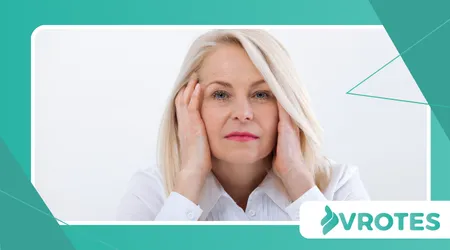Vestibular Issues: Why Menopause Can Affect Your Balance

The onset of menopause brings a cascade of changes, and among the less-discussed yet profoundly impactful are Vestibular Issues.
Anúncios
It is a surprising reality for many women that the body’s internal balancing system, the complex machinery responsible for spatial orientation, can be significantly impacted as reproductive hormones decline.
This shift in equilibrium can manifest as dizziness, vertigo, and a disconcerting loss of balance, fundamentally altering daily life.
The Hormonal Connection: Estrogen and the Inner Ear
Understanding this link requires looking closely at the inner ear’s anatomy.
The vestibular system, housed within this intricate structure, relies on delicate fluid dynamics and nerve signals to tell the brain exactly where the body is in space.
Anúncios
This delicate system is not isolated; it is surprisingly sensitive to hormonal fluctuations.
Estrogen, a key hormone that decreases sharply during perimenopause and menopause, plays a crucial, though indirect, role in maintaining the health of the inner ear.
Estrogen receptors are found in various tissues throughout the body, including components of the inner ear.
Declining estrogen levels can affect the blood flow and fluid regulation within the cochlea and vestibular organs.
A reduction in this vital hormone may lead to changes in the endolymphatic fluid pressure, which is essential for proper signal transmission to the brain.
This subtle pressure shift is often the root cause of the disconcerting spinning sensation characteristic of vertigo.
Understanding the Symptoms of Imbalance
For women transitioning through menopause, these balance problems are often dismissed as simple aging or stress.
However, recognizing the specific nature of these Vestibular Issues is the first step toward effective management.
One of the most common complaints is a sudden, intense vertigo that feels like the room is spinning violently, even when the woman is perfectly still.
Read more: Menopause Symptoms You Didn’t Know Existed
This is more than just lightheadedness; it is a profound rotational sensation.
Another frequent manifestation is dizziness and a chronic feeling of unsteadiness, or disequilibrium, which makes walking on uneven surfaces or in the dark particularly challenging.
Simple actions like getting out of bed quickly can trigger a temporary loss of orientation.
Consider the example of a 52-year-old marketing executive who suddenly finds herself avoiding high shelves at the grocery store.
The slight upward tilt of her head to view a product now brings on a wave of unsettling dizziness, a new and unwelcome limitation.
Or imagine a yoga instructor, 55, whose once-effortless tree pose now feels precarious, requiring constant adjustments and an embarrassing wobble.
These are not failures of skill but rather new neurological realities tied to her hormonal transition.

The Role of Bone Density and Circulation
Beyond direct tissue effects, menopause affects the circulatory system and bone health, indirectly compounding Vestibular Issues.
Estrogen is known to help maintain the elasticity of blood vessels.
Its decline can lead to changes in the microcirculation of the inner ear, which is supplied by tiny, specialized arteries.
See how interesting: The Truth About Black Cohosh: Benefits and Risks
Diminished blood flow can compromise the oxygen and nutrient supply to the sensory cells, affecting their performance.
Moreover, the inner ear contains tiny calcium crystals, or otoconia, that are key to sensing gravity and linear movement.
These crystals are partially suspended in a matrix that can be affected by changes in bone turnover.
As an analogy, think of the inner ear as a highly sensitive carpenter’s level, full of liquid and a bubble that perfectly indicates balance.
Menopause can be like slightly thickening the liquid or making the bubble stickier, throwing off the perfect calibration.
When hormonal shifts disrupt calcium metabolism, it may alter the stability or composition of these otoconia.
If they become dislodged, a condition known as Benign Paroxysmal Positional Vertigo (BPPV) can result, characterized by brief but intense episodes of vertigo with head movement.
A Look at the Evidence Vestibular Issues
While research continues to evolve, significant data supports a physiological link.
A study published in the journal Menopause indicated a higher prevalence of BPPV in postmenopausal women compared to premenopausal women.
++ The Role of Resistant Starch in Blood Sugar Control
Specifically, the study noted that approximately **32% of women diagnosed with BPPV were postmenopausal, suggesting a strong correlation between the end of reproductive years and the susceptibility to this type of Vestibular Issues.
This crucial finding shifts the perception of these symptoms from a random occurrence to a recognized component of the menopausal experience.
Management Strategies and Hope
The good news is that these balance problems are often manageable once correctly identified.
Treatment typically involves a multipronged approach focusing on hormone health and physical therapy.
Hormone Replacement Therapy (HRT) may stabilize the hormonal environment, potentially mitigating some of the vascular and fluid-related changes in the inner ear.
This is a discussion to have with a trusted healthcare professional.
Vestibular rehabilitation therapy (VRT), performed by a specialized physical therapist, is profoundly effective.
This therapy uses specific head and body exercises to retrain the brain to process balance signals more accurately.
For conditions like BPPV, simple canalith repositioning procedures, such as the Epley maneuver, can physically relocate the dislodged inner ear crystals.
This provides immediate, often curative relief for some women.
Lifestyle changes, including reducing caffeine and alcohol, managing stress, and incorporating gentle, daily balance exercises like Tai Chi, also contribute significantly to overall vestibular resilience.
Why endure the constant, destabilizing worry of falling when targeted, effective treatments are readily available?
Taking charge of your balance is taking charge of your quality of life. The time for dismissing these distinct balance issues is over.

Regaining Your Footing Vestibular Issues
Menopause is a journey of transformation, and while its symptoms can be complex, Vestibular Issues represent a solvable challenge.
By acknowledging the profound and specific effects of hormonal decline on the inner ear, women and their healthcare providers can move beyond simple diagnosis to effective treatment.
Understanding the hormonal, circulatory, and bone-health factors at play empowers proactive management, allowing women to regain their footing and step into their postmenopausal years with confidence and stability.
Frequently Asked Questions
Can hormone therapy completely eliminate my vertigo?
HRT can help stabilize the hormonal factors that contribute to inner ear dysfunction, but its effectiveness varies.
It’s often used as part of a comprehensive strategy that includes physical therapy.
What is the single most important thing I can do if I suspect my balance issues are related to menopause?
Consult an Ear, Nose, and Throat (ENT) specialist or a physical therapist specializing in vestibular disorders.
A proper diagnosis is crucial, as treatments for different balance issues vary significantly.
Are these Vestibular Issues permanent?
No. Many menopausal balance problems, especially those related to BPPV, are highly treatable with simple, non-invasive procedures. Others often improve with VRT and hormonal stabilization.
How long does vestibular rehabilitation therapy (VRT) typically last?
The duration varies depending on the severity and underlying cause, but many women see significant improvement within a few weeks to a couple of months of consistent therapy.
++ Relationship between vestibular dysfunction and quality of life in climacteric women
